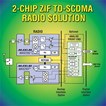New Maxim Two-Chip Radio Solution Is Spec-Compliant For TD-SCDMA Phones

Sunnyvale, CA -- Maxim Integrated Products has introduced the MAX2392 and MAX2507 RF to baseband TD-SCDMA radio-solution reference designs. With the MAX2392 and MAX2507, Maxim is the first company to bring a two-chip radio solution to the TD-SCDMA market. This approach makes a small form factor possible in handsets and data card applications.

Available as an analog or digital interface, each reference design encompasses the entire functionality of the radio -- from antenna to baseband. A 100-pin connector lets the radio interface with, and be controlled by, a PC or baseband emulator. Easy-to-use software exercises the chipset through all its operating modes.
"It is our goal to ensure our customers' success by not only offering them state-of-the-art IC solutions, but also by reducing the amount of engineering effort needed to make the radio spec compliant in the end application," Hans Dropmann, director of business management for wireless products, said.
Maxim's new analog interface reference design features the company's Zero-IF radio solution, comprised of the MAX2392 receiver and the MAX2507 transmitter plus power amplifier. Both parts are manufactured using the company's SiGe BiCMOS technology. The MAX2392 receiver includes RF LNA, direct conversion mixers, baseband filters for TD-SCDMA channel filtering, and AGC amplifiers. The chip also integrates a VCO and synthesizer. This single device reduces cost, size, and component count by at least 50% when compared to a superheterodyne implementation.
The MAX2507 transmitter is a production-ready, fully spec compliant SiGe transmit IC including not only the power amplifier, but also the entire transmit circuitry required for a high-dynamic-range CDMA system without needing external power-control circuitry. This IC accepts baseband inputs and upconverts them to the RF frequency using on-chip frequency translators, VCO, and synthesizers. This integration results in approximately 40% size reduction compared to competitive solutions. The MAX2507 is also the first IC with integrated PA to meet the tough cellular performance requirements for the TD-SCDMA or any cellular phone standard.
For customers who do not have the baseband data conversion integrated onto their chosen baseband processor, Maxim offers a Digital Interface Reference design that includes a third chip, the MAX19700. The MAX19700 family of baseband converters is an ultra-low-power, mixed-signal analog front-end (AFE) designed for TD-SCDMA handsets and data cards. Optimized for high dynamic performance at ultra-low power, the MAX19700 integrates an array of components: a dual 10-bit, 11 Msps receive ADC and dual 10-bit, 11 Msps transmit DAC with TD-SCDMA low-pass Tx filters. Typical operating power is 38 mW at Fclk = 5.12 Msps with AVDD = +3 V and OVDD = +1.8 V. The device also integrates three 12-bit control DACs for fast level-setting AGC, VGA, and AFC.
The MAX2392 is packaged in a 28-pin leadless thin QFN that measures 5 mm by 5 mm. The MAX2507 is packaged in a 48-pin leadless LGA that measures 7 mm by 7 mm. The MAX19700 is packaged in a 48-pin leadless thin QFN that measures 7 mm and 7 mm.
Samples of these solutions are available today; production release will be complete by Spring of 2005.
Source: Maxim Integrated Products
